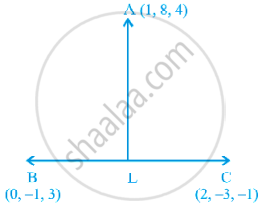Advertisements
Advertisements
Question
Find the co-ordinates of the foot of perpendicular drawn from the point A(1, 8, 4) to the line joining the points B(0, –1, 3) and C(2, –3, –1).
Solution
Let L be the foot of perpendicular drawn from the points A (1, 8, 4) to the line passing through B and C as shown in the Figure.
The equation of line BC by using formula `vecr = veca + lambda(vecb - veca)`, the equation of the line BC is
`vecr = (-hatj + 3hatk) + lambda(2hati - 2hatj - 4hatk)`
⇒ `xhati + yhati + xhatk = 2lambdahati - (2lambda + 1)hati + lambda(3 - 4lambda)hatk`
Comparing both sides, we get
`x = 2lambda, y = -(2lambda + 1), z = 3 - 4lambda` ......(1)
Thus, the co-ordinate of L are `(2lambda, -(2lambda + 1), (3 - 4lambda)`
So that the direction ratios of the line AL are `(1 - 2lambda), 8 + (2lambda + 1), 4 - (3 - 4lambda)`
i.e. `1 - 2lambda, 2lambda + 9, 1 + 4lambda`
Since AL is perpendicular to BC, we have
(1 – 2λ) (2 – 0) + (2λ + 9) (–3 + 1) + (4λ + 1) (–1 –3) = 0
⇒ `lambda = (-5)/6`
The required point is obtained by substituting the value of λ, in (1), which is `((-5)/3, 2/3, 19/3)`.
APPEARS IN
RELATED QUESTIONS
The x-axis and y-axis taken together determine a plane known as_______.
Find the image of:
(–5, 0, 3) in the xz-plane.
Find the image of:
(–4, 0, 0) in the xy-plane.
Find the distances of the point P(–4, 3, 5) from the coordinate axes.
Determine the point on z-axis which is equidistant from the points (1, 5, 7) and (5, 1, –4).
If A(–2, 2, 3) and B(13, –3, 13) are two points.
Find the locus of a point P which moves in such a way the 3PA = 2PB.
Verify the following:
(0, 7, –10), (1, 6, –6) and (4, 9, –6) are vertices of an isosceles triangle.
Verify the following:
(0, 7, 10), (–1, 6, 6) and (–4, 9, –6) are vertices of a right-angled triangle.
Verify the following:
(5, –1, 1), (7, –4,7), (1, –6,10) and (–1, – 3,4) are the vertices of a rhombus.
Find the locus of the points which are equidistant from the points (1, 2, 3) and (3, 2, –1).
Find the ratio in which the sphere x2 + y2 + z2 = 504 divides the line joining the points (12, –4, 8) and (27, –9, 18).
Write the distance of the point P(3, 4, 5) from z-axis.
Find the point on y-axis which is at a distance of \[\sqrt{10}\] units from the point (1, 2, 3).
The ratio in which the line joining the points (a, b, c) and (–a, –c, –b) is divided by the xy-plane is
Find the direction cosines of the line passing through the points P(2, 3, 5) and Q(–1, 2, 4).
Find the coordinates of the point where the line through (3, – 4, – 5) and (2, –3, 1) crosses the plane passing through three points (2, 2, 1), (3, 0, 1) and (4, –1, 0)
A plane meets the co-ordinates axis in A, B, C such that the centroid of the ∆ABC is the point (α, β, γ). Show that the equation of the plane is `x/alpha + y/beta + z/γ` = 3
Find the image of the point (1, 6, 3) in the line `x/1 = (y - 1)/2 = (z - 2)/3`
If a line makes angles `pi/2, 3/4 pi` and `pi/4` with x, y, z axis, respectively, then its direction cosines are ______.
If a line makes angles α, β, γ with the positive directions of the coordinate axes, then the value of sin2α + sin2β + sin2γ is ______.
Find the equation of the plane through the points (2, 1, 0), (3, –2, –2) and (3, 1, 7).
Find the equations of the two lines through the origin which intersect the line `(x - 3)/2 = (y - 3)/1 = z/1` at angles of `pi/3` each.
O is the origin and A is (a, b, c). Find the direction cosines of the line OA and the equation of plane through A at right angle to OA.
Two systems of rectangular axis have the same origin. If a plane cuts them at distances a, b, c and a′, b′, c′, respectively, from the origin, prove that
`1/a^2 + 1/b^2 + 1/c^2 = 1/(a"'"^2) + 1/(b"'"^2) + 1/(c"'"^2)`
Find the length and the foot of perpendicular from the point `(1, 3/2, 2)` to the plane 2x – 2y + 4z + 5 = 0.
The sine of the angle between the straight line `(x - 2)/3 = (y - 3)/4 = (z - 4)/5` and the plane 2x – 2y + z = 5 is ______.
The direction cosines of the vector `(2hati + 2hatj - hatk)` are ______.
The vector equation of the line through the points (3, 4, –7) and (1, –1, 6) is ______.
